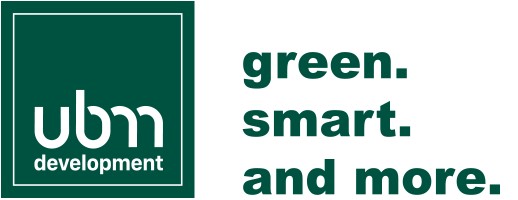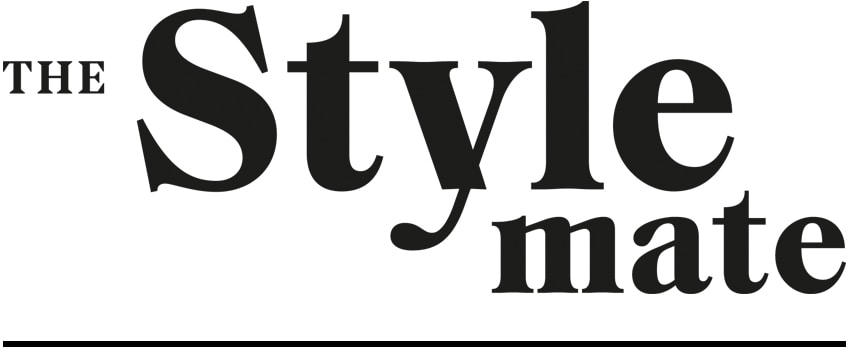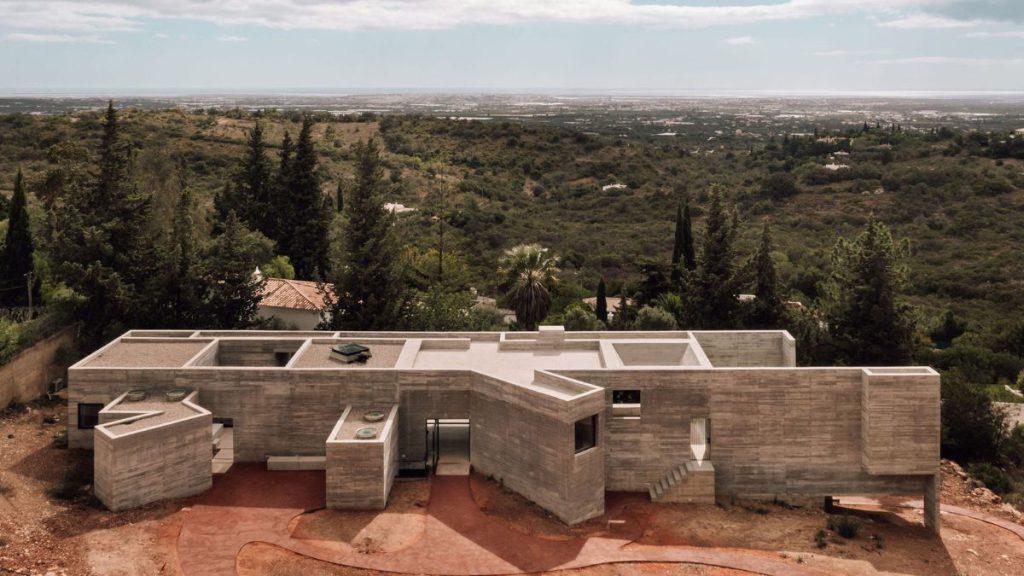The Frame House in the Algarve, designed by Pedro Domingos Arquitectos, polarises opinion like few other buildings. It is about as brutalist as a residential building can get. And so the power of the project lies not only in its unadulterated style, but also in sparking discourse about architecture.
On a hill above Santa Bárbara de Nexe, a small community in the hinterland of the Portuguese Algarve, stands a building that oscillates between ruin and monument. With its austere concrete walls, flat roofs and radically minimalist design language, it looks like a relic from another time.
Or like a statement deliberately directed against all expectations of Mediterranean living culture. Because that’s what it is: no whitewashed walls, no square floor plan with interlocking extensions and projections, no terracotta colour palette, no playful archways, no red tiled roofs. Typical of the Mediterranean style.
The language of reduction and authenticity
The house, which from a distance looks like a castle or military installation, reveals itself on closer inspection to be an architectural experiment in the spirit of brutalism. Exposed concrete, raw surfaces, clearly defined geometries: everything about this building speaks the language of reduction and authenticity.

But instead of warm colours and traditional materials, the design focuses on cool austerity and uncompromising form. You have to want that. And so the comments from users on design and architecture websites about the Frame House are very controversial. They range from rapturous enthusiasm to sheer horror: from “Exquisite. Hejduk meets Studio Ensamble. Brutalism is back. Finally‘ to ’Minimalist hellscape. It would fit in with Planet of the Apes!” Everything has been said so far.
Frame House: Brutalism in a new form
But this is nothing new: brutalist architecture, which reached its peak in the 1950s and 1960s with buildings such as Le Corbusiers „Unité d’Habitation“,(literally translated as ‘housing units’) and the university buildings in London, has always been polarising. Its raw materiality, which uses concrete as its primary means of expression, often contrasted with ideas of comfort and cosiness. But this was precisely where its revolutionary claim lay: architecture should be honest, unadorned, free of decorative frills.

The house in the Algarve, designed by Pedro Domingos Arquitectos takes up this idea but updates it for a new era. Where large-scale residential complexes and public buildings once set the stage for brutalism, here the architectural style appears in the private sphere. A residential building that deliberately turns its back on the image of a cosy retreat, on what one would expect to find in the midst of this Mediterranean landscape with its typical architecture.
Architecture as a powerful counterpart
The location was not chosen at random. Situated on a hill, far away from urban constraints, the building opens up to the landscape and the sky. However, the distant view over the wooded hills and the sea is not romantically staged, but framed by sharp-edged openings and austere frames. Here, architecture does not become a harmonious mediator between man and nature. It becomes a powerful counterpart.


The building consists of several interlocking volumes, all of which are the same height. This horizontal austerity gives the ensemble an almost archaic presence. Viewed from below, Frame House resembles a ruin – an association that is not coincidental. The design plays with the image of the unfinished, the fragmentary, and deliberately rejects smooth perfection.
Living between austerity and freedom
But what is it like to live in a house like this? Both inside and out, there is an ‘aesthetic’ of austerity. Generous concrete surfaces, minimal furnishings and an almost monastic severity characterise the rooms. The kitchen, traditionally the heart of a Mediterranean home, appears here as a functionally minimalist workspace – far from cosy, but consistent with the overall architectural concept. And for some, therefore, probably more of a nightmare.

This approach raises questions: Is such a house really intended for living in, or is it rather a manifesto, a sculpture on a 1:1 scale? The boundary is fluid. On the one hand, the spaciousness of the rooms allows for an intense experience of space, light and materiality. On the other hand, there is a lack of connection to everyday life and humanity that one would expect in a residential building.
Between history and the present day
The Algarve is a region steeped in history, characterised by castles, monasteries and fortresses, some of which remain as ruins. The Frame House inevitably becomes part of this cultural memory. It appears as a contemporary continuation of defensive architecture: a bunker, a refuge, and certainly a statement of permanence.

At the same time, it points to a global trend in contemporary architecture. Brutalism, long dismissed as a relic of past decades, has been experiencing a rediscovery in recent years. Young architects are taking up its principles, transforming them and once again using concrete as an aesthetic and substantive medium. The Portuguese example of the Portuguese firm Pedro Domingos Arquitectos is part of this movement – not as a copy, but as an independent interpretation.
Beauty in the raw and imperfect
An architecture that provokes and divides. One thing is certain: the Frame House leaves no one indifferent. Its quality lies precisely in its deliberate incompleteness, its raw materiality and its renunciation of decorative additions. Here, beauty does not arise from comfort or ornamentation, but from the clarity of form and the consistency of attitude.


Whether you love or hate the house, whether you can imagine living in it or not, it opens up a conversation about what architecture can be today. At a time when many residential buildings oscillate between standardisation and ‘lifestyle marketing,’ Frame House sends a strong message. It challenges us to think about the essence of building – about materials, space and the relationship between people and their environment.
Contribution to architectural discourse
The fact that this debate is taking place in a location that many people associate primarily with sun, sand and Mediterranean ease makes the contrast all the more exciting. This is not a holiday home, but an architectural manifesto that radically and unwaveringly represents a certain attitude.


The brutalist Frame House near Santa Bárbara de Nexe is much more than a private retreat. It is an architectural experiment that defies convention, provokes and polarises. It rejects the familiar notion of domesticity and replaces it with an aesthetic austerity that can be both fascinating and repellent, even repulsive.
The Frame House thus joins the discourse on the return of brutalism. It shows that architecture still has the power to spark debate, provoke irritation and open up new perspectives. And that is precisely where its greatest strength lies.
Text: Linda Benkö
Fotos: Pedro Domingos Arquitectos



iThere are no comments
Add yours